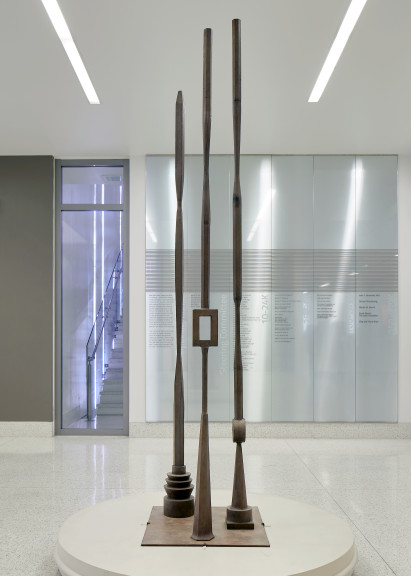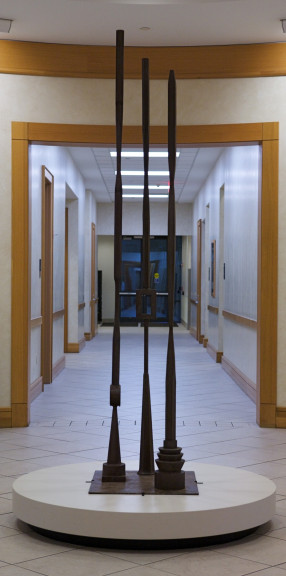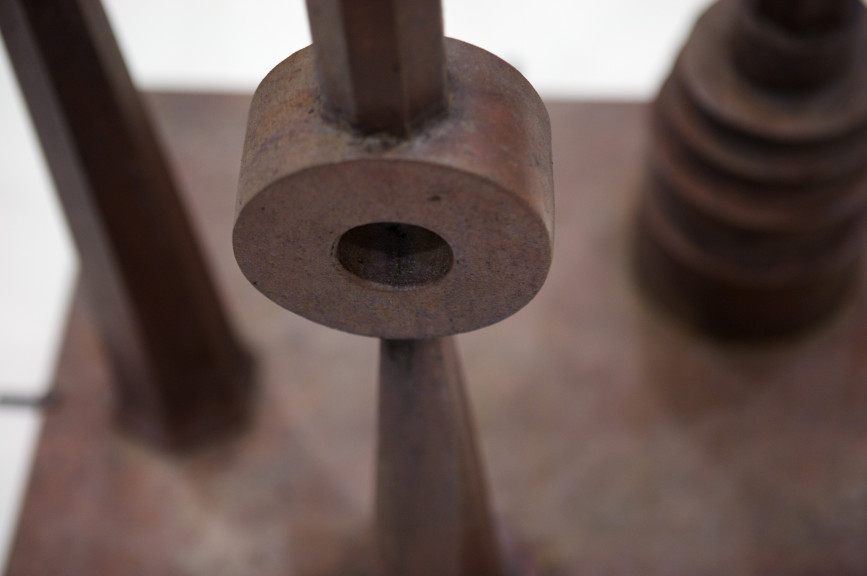Harmonious Triad
Beverly Pepper
96 × 26 × 24 inches
Lent by The Metropolitan Museum of Art, Gift of Charles Cowles, 1983
1983.521a-d
GPS: 30.285149, -97.735265
Restlessly inventive, Beverly Pepper made significant contributions to post-war sculptural styles and movements. After studying painting and sculpture in Paris following World War II, Pepper settled in Rome in 1950. She worked with clay and wood throughout the 1950s before transitioning to large metal sculptures that feature thin, ribbon-like strands of steel looping and curling through space. By the mid-1960s, she began incorporating geometric forms into her work, such as open, chrome-plated boxes that conveyed a sense of motion, aligning with the emergence of Minimalism.
Pepper was one of ten artists invited to Spoleto, Italy, in 1962 to create sculpture in local steel factories. There, she became friends with pioneering steel sculptor David Smith (1906–1965). Like Smith, Pepper learned to cut and weld large sheets of steel so that she could fabricate her own sculptures.
A leading figure in the Land art movement of the early 1970s, Pepper executed commissions for universities, corporate collections, and public plazas. Her first project, designed for the Northpark Center in Dallas (1971), featured low-lying triangular and pyramidal forms sloping into and out of the ground. Her sensitivity to the environment informed later works, including a group of monumental sculptures constructed in 1979 for the Piazza del Popolo in Todi, Italy. Inspired by Roman landmarks such as the Columns of Trajan and Marcus Aurelius, Pepper constructed four towering steel columns (rising 35 feet tall) that resemble industrial tools. “They’re an extension of my hands,” she said. “I’ve always worked with tools. I simply began to transfigure them.”
The totemic forms of Harmonious Triad developed out of the Todi monuments. Dissatisfied with the color and texture of Corten steel, which was then the most common material used for large-scale sculptures, Pepper experimented with ductile iron at the John Deere Foundry in Illinois. In Harmonious Triad and other works from this period, she pioneered its use as a sculptural material. Though its vertical poles may suggest the human figure, Pepper intended them as pure abstraction.
ACTIVITY GUIDES
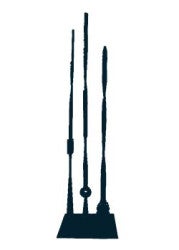
Harmonious Triad
Beverly Pepper
Subject: Rhythm
Activity: Drawing to express rhythm
Materials: Large paper, finger paint or other pigments
Vocabulary: artist, column, repetition, rhythm, sculpture, unity
Explain to your child that when we listen to different kinds of music, the beat can be fast or slow. The speed of the beat is called rhythm. Sometimes artists will repeat the same part several times in order to create a visual flow. This is also called rhythm.
This artist creates a visual flow by repeating certain parts. By using more than one column in this sculpture, she creates a regular visual flow with three repetitions.
What does this sculpture look like?
What parts are repeated? How many times?
If this sculpture were a piece of music, how would it sound? Would it be fast or slow?
Did the artist give this sculpture a good name? Why or why not?
Distance, quantity, and scale can alter the way we read visual rhythm. Note that the repetition of forms look different if they are large or small, close together or far apart, and if there are less or more forms repeated.
Ask your child to vocalize visual rhythms. Walk around and point at repeated forms and express them in sound. Suggest higher, faster sounds for small repeated objects (like books on a shelf) and lower, slower sounds for large repeated objects (like electrical poles). Then make a drawing in which the child repeats forms, such as circles, lines, or squiggles. Encourage him or her to vocalize appropriate sounds while drawing.
Artist - someone who makes things, such as paintings and sculptures
Column - a tall shaft that holds something up, usually the front of a building
Repetition - the act of repeating something over and over
Rhythm - the flow of repeated things that are alike
Sculpture - a work of art that has height, width, and depth
Unity - bringing parts together
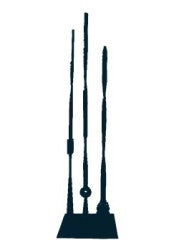
Harmonious Triad
Beverly Pepper
Subject: Geometric abstraction
Activity: Making a drawing using vertical and horizontal lines
Materials: Paper, pencil, a ruler
Vocabulary: Geometric abstraction, horizontal, iron, vertical
Beverly Pepper was born in Brooklyn, New York. She began her career making paintings, but eventually she became a sculptress. She studied with other sculptors in Paris, France, and then she moved to Italy. After sculpting in wood with carpentry tools, such as handsaws, she learned to sculpt in metal, which is very difficult work. Beverly Pepper’s style was geometric abstraction.
Do the columns make horizontal or vertical lines?
What do you think the title means?
What material was used to create this sculpture?
What mood do these lines convey?
Beverly Pepper used vertical lines to create this sculpture. Using a ruler, make an abstract drawing with lines that are both vertical and horizontal. Does your drawing look harmonious? Why or why not?
Geometric abstraction – geometric shapes that are not realistic
Horizontal – positioned the same as the horizon and the opposite of vertical
Iron – a strong dark metal
Vertical – positioned upright, like a flagpole, and opposite of horizontal
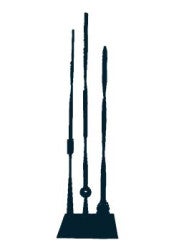
Harmonious Triad
Beverly Pepper
Subject: Harmony and unity
Activity: Making a harmonious sculpture
Materials: Styrofoam, popsicle sticks or chopsticks
Harmony: Geometric Abstraction, symbolism, harmony
Beverly Pepper was born in Brooklyn, New York in 1924. Before becoming a sculptor she was a painter. She studied in France and Italy with master sculptors like Fernand Leger, Alexander Calder, and David Smith. Pepper was one of few female sculptors working in metal, and one of few sculptors to fabricate their own works (most artists had their large metal works made in factories). Beverly Pepper is interested in expressing timeless human experiences and emotions through geometric forms. This is a style called Geometric Abstraction. In Harmonious Triad, the artist created three columns that are alike but unique. By placing them in a row, these three similar objects create a composition that is interesting and varied while still having unity and balance as a whole.
What human experiences or emotions might Pepper be representing in this work? Why do you think so?
Does this piece resemble columns or totems? Where do we usually find columns or totems? What function do these forms usually represent?
How does the title influence our understanding of the work?
Using styrofoam as a base, insert popsicle sticks or chopsticks into the foam so they stand vertically. Experiment with arranging them so as to create a composition that utilizes visual harmony and unity. Try using equal numbers of vertical lines and repetition to achieve this.
Geometric Abstraction -- a style of art that uses geometric shapes to create a composition that is not representational or realistic
Symbolism -- representing an idea or concept through images
Harmony -- having balanced or equal parts
MORE INFORMATION
Beverly Pepper was born in Brooklyn, New York, where she first studied painting and industrial design at the Pratt Institute. In the early 1940s, she developed geometric and biomorphic abstract styles derived from European modernists. After World War II, Pepper studied art in Paris at the studios supervised by the cubist painters Fernand Léger and André Lhote and sculptor Ossip Zadkine. In 1951 she moved permanently to Italy, near Rome, although from 1963 on she has worked part of each year in the United States, where most of her works have been exhibited and sold.
Turning from painting to sculpture in 1960, Pepper first carved in wood, a plentiful and inexpensive material. Instead of hand chisels, she preferred power tools as appropriate to the modern Machine Age. In 1962 the organizer of the music and art festival at Spoleto, Italy, invited ten sculptors to use local steel factories as their studios for a month. Of the three Americans, two were well-established masters of abstract metal constructions: Alexander Calder and David Smith. The third was Pepper, who did not yet even know how to weld. So she apprenticed herself to an ironmonger and shortly thereafter made her first steel sculpture, nearly eighteen feet tall. Thereafter, Pepper sculpted only in metal on a monumental scale, preferably for installation outdoors in urban spaces.
In the 1960s, it was virtually unprecedented for women to use the physically arduous, industrial methods of cutting and welding heavy sheets of steel. Pepper established her own well-equipped studio partly because she did not like delegating the actual work to fabricators; in this practice she was the antithesis of other sculptors working in steel who sent their compositions to be fabricated by others.
In terms of style, Pepper’s austerely geometric constructions in the mid-1960s had much in common with the disciplined geometry and systemic repetition of basic modules advocated by minimalist sculptors at the time. Like Tony Smith and Donald Judd, she composed sculptures in which a basic form, often a square or cube, was repeated in a spatial progression. By the 1980s, however, she preferred autonomous forms grouped together.
Harmonious Triad, 1982–83
In keeping with the modernist precept “less is more” (first advocated by the German-born architect Mies van der Rohe), this sculpture consists of three tall, very slender columns on a low square pedestal. Although entirely abstract, these verticals may suggest standing figures, but this was not Pepper’s intention. Here there is only an exquisite subtlety of form and placement. Her purely aesthetic goals become clear when Harmonious Triad is compared to Seymour Lipton’s sculptures Pioneer and Guardian.
Pepper’s disinterest in allusions extends to the titles of her works. The word “triad” might allude to numeric symbolism (in religion, for example, three has many associations, such as the Christian and Hindu divine trinities). But Pepper was uninterested in any references beyond pure abstraction.
Valerie Fletcher is Senior Curator at the Hirshhorn Museum in Washington, DC. Her research on groundbreaking aspects of international, globalized, and transnational art have resulted in numerous exhibitions and publications.
Baker, Kenneth. “Interconnections: Beverly Pepper.” Art in America 72(April 1984): 176–79.
Bertelli, Carlo, Bruno Corà, and Diane Kelder. Beverly Pepper a Forte Belvedere: Trent’Anni di Scultura. Milano: Electa, 1998.
Butterfield, Jan. “Beverly Pepper: ‘A Space Has Many Aspects.’” [interview] Arts Magazine 50 (September 1975): 91–94.
Krauss, Rosalind. Beverly Pepper: Sculpture in Place. New York: Abbeville Press, 1986. Introduction by Douglas G. Schultz.
Morgan, Anne Barclay. “Memory, Monuments, Mystery, and Iron: An Interview with Beverly Pepper.” Sculpture 17 (April 1998): 34–39.
Solomon, Deborah. “Woman of Steel.” Art News 86 (December 1987): 112–17.
Summers, Patricia M. “Sentinels Through Time: Beverly Pepper’s ‘Markers’.” Sculpture 22 (September 2003): 40–45.
Thompson, Walter. “Beverly Pepper: Dramas in Space.” Arts Magazine 62 (Summer 1988): 52–55.
Tyler School of Art in Rome, Temple University Abroad. Beverly Pepper: Sculpture, 1960–1973. Rome, 1973.
The Metropolitan Museum of Art in New York generously loaned twenty-eight modern and contemporary sculptures to Landmarks for display throughout the Austin campus. The collection represents a broad array of artists working in the second half of the twentieth century. The initial sculptures were installed throughout the main campus in September 2008, and a second, smaller group were unveiled at the renovated Bass Concert Hall in January 2009.
Funding for the loan was provided by the Office of the President. This project was the result of a collaborative effort among many, including:
Leadership
Andrée Bober and Landmarks
Pat Clubb and University Operations
Douglas Dempster and the College of Fine Arts
Landmarks Advisory Committee
William Powers and the Office of the President
David Rea and the Office of Campus Planning
Bill Throop and Project Management and Construction Services
Gary Tinterow and the Metropolitan Museum of Art
Samuel Wilson and the Faculty Building Advisory Committee
Project Team
Chuck Agro, transportation, Metropolitan Museum of Art
Andrée Bober, curator and director, Landmarks
Caitlin Corrigan, registrar, Metropolitan Museum of Art
Cynthia Iavarone, collections manager, Metropolitan Museum of Art
Cliff Koeninger, architect
Ricardo Puemape, Project Management and Construction Services
Kendra Roth, conservator, Metropolitan Museum of Art
Patrick Sheehy, installation services
Nicole Vlado, project manager, Landmarks
Special Thanks
Valerie Fletcher, curatorial contributor
Beth Palazzolo, administrative coordination, University Operations
Russell Pinkston, composer
What’s Past Is Prologue: Inaugurating Landmarks with the Metropolitan Sculptures
With the arrival of twenty-eight modern sculptures on long-term loan from New York’s Metropolitan Museum of Art, the Landmarks program has begun. Their installation throughout the Austin campus offers a remarkable opportunity to survey some of the major trends in art during the second half of the twentieth century. These sculptures allow us to witness the distinctly modern dialogue between representation and abstraction, as well as the contest between natural and industrial materials. Most of all, we can celebrate their presence as an unprecedented chance to experience works of art first-hand––to appreciate their forms and to understand the underlying ideas.
The Landmarks program perpetuates in Austin one of civilization’s oldest and most enduring traditions: the placing of art in public areas, accessible to nearly everyone and expressive of collectively held ideas. More than five thousand years ago, the cultures of Egypt and Mesopotamia produced sculptures for urban plazas, government buildings, and places of worship to express political, secular, and religious values. Grand monuments endorsed the ruling elite and commemorated military victories, while images of deities symbolized spiritual beliefs. The original purposes of public art were primarily ideological and didactic, but what has endured through the ages is the physical beauty of the art. In modern times the contexts and goals for public art have changed considerably. In many parts of the world democracy and egalitarianism have supplanted absolute rulers, and explicit religious power has yielded to secular humanism. During the mid-to-late twentieth century (the era when the Metropolitan’s sculptures were created), globalization has redefined the entire world. Societies in Europe and the Americas have became so diverse that cultural authorities can no longer be sure of which systems of meaning and which values, let alone which individuals, should be honored in the traditional ways of public art.
A schism has developed between traditionalists and modernists. In a rapidly changing world those who wanted to preserve the familiar in art have continued to commission representational statues. Modernists, on the other hand, have embraced change and gladly jettisoned the old ways in favor of abstraction. The schism is exemplified by two famous memorials in Washington, D.C., both intended to commemorate the heroic sacrifices of American armed forces. The Marine Corps Memorial (1954) consists of a superbly realistic representation of soldiers struggling to raise the American flag on Iwo Jima in 1945. In contrast, the Vietnam Memorial (1982) consists of a massive V-shaped wedge of polished black stone inscribed with What’s Past Is Prologue: Inaugurating Landmarks with the Metropolitan Sculptures July 2008 the names of the dead. At the time it was inaugurated, this monument shocked nearly everyone outside the art world and outraged many of those it intended to commemorate. In response, a group of bronze figures of soldiers was added. But soon, precisely because of its universal form and absence of imagery, the original memorial became a powerful place where all Americans could go to grieve, remember, and pay homage. To most of the art world, this demonstrated beyond a doubt the viability of abstract sculpture for public places.
With America’s increasing wealth and social consciousness in the 1960s many towns began to institute programs of commissioning sculptures for public places. By requiring that 1 or 2 percent of each building’s construction budget be used for art, urban planners sought to improve the living and working environment for millions of people. The main difficulty was agreeing on what kind of art was visually pleasing and, just as important, potentially meaningful to the general public. Two highly publicized examples were the huge, abstract, metal sculptures by Pablo Picasso and Alexander Calder, in Chicago and Grand Rapids respectively, which at first provoked derision but gradually became a source of community identity and pride.
One way to approach works of art is to consider the historical context in which they were created. During the first half of the twentieth century, life and art underwent radical transformations. Industrial manufacturing supplanted agriculture as the dominant mode of production, people migrated from rural areas to urban centers, women and minorities gained equal rights, warfare expanded to an unprecedented global scale, and technology accelerated the pace of life—and art changed in tandem.
Abstraction
Early in the modern era, many artists believed that a new visual language was needed to replace the Greco-Roman classical figurative traditions that had persisted through two millennia. Photography had made mimesis (accurate depiction of reality) unnecessary in painting and sculpture for the first time in history. Artists were free to conceive radically new approaches, and so abstraction was born, emerging from 1910 to 1920 in Europe. Initially artists simplified and stylized observed reality into organic and angular forms. That first phase soon evolved into making “pure” abstractions with no recognizable sources. From the outset, abstract art carried implicit meanings recognized by artists and informed viewers but largely lost on the general public.
Early abstractionists intended their art to convey their commitment to an ongoing transformation of society. Like Morse code in telegraphy and other new modes of communication fundamentally different from the traditional written word, abstract forms in art could convey meanings—not narrative or literal ones but broad ideas that could speak to an international audience and help advance human consciousness.
During the 1920s and 1930s, artists developed two broad types of abstraction: geometric and biomorphic. Geometry denotes mathematics and suggests such related disciplines as architecture, design, engineering, and logic as well as intangible qualities like analytical thinking and precision—desirable attributes for a rational, communal society. Artists devised a new language of geometry in art: horizontal and vertical elements can convey calm, harmony, and stability (see Harmonious Triad by Beverly Pepper), while rising diagonals can suggest energy and optimism (see Column of Peace by Antoine Pevsner and Square Tilt by Joel Perlman).
In contrast to geometric abstraction, a number of artists favored softer forms and curving contours. Inspired by sources in nature, biomorphic abstractions evoke natural phenomena, biological processes, growth, and ambiguity (see Big Indian Mountain by Raoul Hague, Source by Hans Hokanson, and Untitled [Seven Mountains] by Ursula von Rydingsvard). Such works stand in general opposition to the industrial and technological aspects of modern life; they remind us of the fundamental importance of the natural world. Biomorphism was invented and advocated by the surrealists, who believed in the importance of the unconscious mind in creating and understanding modern art. Relying on the Freudian concept of free association, such artists expect viewers to generate their own unique responses to abstract art.
The two types of abstraction began as competing and opposing philosophies, but by the 1950s many artists expertly combined them to suit their expressive needs (see the rhythmic contours of Veduggio Glimpse by Anthony Caro and the disconcerting, hulking forms of Catacombs and Guardian by Seymour Lipton).
By the 1960s, the original philosophical meanings underlying abstraction had mostly faded away, leaving “formalist” aesthetics: the creation and appreciation of pure nonreferential beauty. Formalism dominated much artistic practice from the 1950s through the 1970s, particularly in the United States in the circle around the critic Clement Greenberg. Geometric sculptures became ubiquitous in public places—some complex and sophisticated and some merely competent. A group known as the minimalists advocated an intellectually rigorous, austerely reductivist approach (see Amaryllis by Tony Smith). Other artists went in the opposite direction, toward complexity and a decorative verve (see Kingfish by Peter Reginato). From those extremes emerged the postminimalists, who infused organic vitality into simple, singular forms (see Curve and Shadow No. 2 by Juan Hamilton).
Figuration
Despite the enthusiasm for abstraction in midcentury, a number of artists insisted on maintaining recognizable human content in their works. Abstraction had alienated many viewers who found it remote or incomprehensible. Yet few artists returned to traditional realism, preferring instead to explore new and evocative modes of representation.
The strongest resurgence occurred in the aftermath of World War II. Many artists, especially in Europe, wanted to pay homage to the sufferings experienced by so many people during the war and to their struggles to rebuild their lives and societies amidst the new fears engendered by the nuclear age and the Cold War. This atmosphere of postwar existential anxiety was poignantly expressed in two museum exhibitions in the 1950s: models for a never-realized Monument to the Unknown Political Prisoner at London’s Tate Gallery in 1953 and the avowedly humanist theme of the New Images of Man installation at New York’s Museum of Modern Art in 1959.
Many postwar sculptors expressed their angst by portraying figures or fragments of bodies as falling, broken, injured, or partially robotic (see Augustus by Bernard Meadows and Figure by Eduardo Paolozzi). Some erudite artists reinterpreted classical myths, particularly those in which a hero challenged the gods and were punished: Icarus, Hephaestus, Prometheus, Sisyphus (see works by Koren der Harootian and Frederick Kiesler). Seymour Lipton created a particularly effective amalgam of figure references within abstract forms that harbor dark inner spaces (see Pioneer, Catacombs, and Guardian).
Representational sculpture was submerged by the tidal wave of abstraction in the 1960s and 1970s, but a new generation insisted on a legible humanist content in art, addressing issues of personal identity and isolation in an impersonal world (see Eyes by Louise Bourgeois and Figure on a Trunk by Magdalena Abakanowicz).
Materials and Methods
Modern sculptors also introduced a new language of materials and methods. In the late nineteenth century, sculpture making had entered a new phase of mass production made possible through technology: bronzes could be produced in large editions by skilled technicians from an artist’s original. The Thinker by Auguste Rodin, for example, was made in several editions, ranging from a dozen life-size bronzes to hundreds of smaller casts. This mechanization and concomitant commodification of art prompted a reaction. Appearing simultaneously in several countries, the “direct carve” movement advocated older craft-based methods and sought to enhance the intrinsic characteristics of natural materials: the color and grain of exotic woods or the veining and crystalline structure of unusual stones. By the 1920s, this aesthetic had gained international prominence, and it persists to this day.
The first generation of direct carvers admired prehistoric, African, Oceanic, and indigenous American artifacts. By adapting the hieratic frontality and stylized forms of those sources to the sleekly refined forms of abstraction, modern sculptors could represent simplified figures linked in sophisticated linear rhythms (see works by Koren der Harootian and Anita Weschler). Recent artists of this orientation tend to work on a larger scale and may roughly cut and hew wood to achieve expressionistic textures (see works by Hans Hokanson and Ursula von Rydingsvard).
Carvers remained a relatively small minority in modern sculpture, far outnumbered by “direct metal” sculptors. Their approach emerged in prewar Europe and burgeoned into an international movement in the 1950s and 1960s. Seeking materials and methods appropriate to the modern Machine Age, artists looked to engineering and construction for inspiration. Instead of using chisels to carve wood and stone, constructivists preferred welding torches to cut and join pieces of metal. Their structures ranged from elegant abstractions to assemblages of cast-off objects.
The industrial analogy and model extended to the sculptors’ own studios, which resembled factory spaces with heavy-duty equipment. Some—like Anthony Caro, Willard Boepple, and Robert Murray—found inspiration in working spontaneously and experimentally with sheet metal: cutting, folding, rolling, welding, soldering, and sometimes painting or burnishing it. Other sculptors, notably Tony Smith, were comfortable with sending models to factories for professional fabrication. Both methods were considered appropriate for a modern world that had been so fundamentally reshaped by industrial manufacture.
In contrast, many sculptors preferred to make assemblages from miscellaneous bits and pieces of scrap, sometimes irreverently called “junk sculpture.” Although artists had experimented with this approach as early as the 1910s, it became a widespread tendency only decades later in the 1950s and 1960s, when sculptors made three-dimensional collages from the detritus of industrial manufacture and mass consumption: rusty machinery, old car parts, squished used paint tubes, broken musical instruments, virtually anything. The motivations for using trash range from simple necessity (when an artist has no money to buy new materials) to antimaterialistic social criticism and environmentalism (sculptors started recycling long before the idea occurred to others).
Regardless of the motivations, a found-object sculpture possesses an inherent dual identity: its former reality as a useful thing and its new reality as art. That dualism inevitably poses an intellectual and visual conundrum for us. Do we see Deborah Butterfield’s Vermillion primarily as a lifelike depiction of a horse or as a composition of rusty, crumpled bits of metal thrown out by a wasteful consumerist society? And what are we to understand from Donald Lipski’s seemingly abstract The West, which consists of decontextualized harbor buoys and lots of corroded pennies? The artists offer clues and hope that we will use our own eyes, intellect, intuition, and imagination to make connections and create meanings.
Landmarks: Sculptures for Inquiring Minds
Unlike works in private collections or even museums, public sculptures exist in our daily environment, interact with our activities, and enter our awareness repeatedly and variously. Beyond the pleasure they bring to viewers already acquainted with art, they can stimulate curiosity and spark new perceptions in the minds of passersby who might otherwise not have much aesthetic experience. As the university’s population seeks knowledge in classes, libraries, and laboratories, the Landmark sculptures can offer other kinds of discoveries. Visitors to the Perry Castañeda-Library, the Nano Science Technology Building, the School of Law, and elsewhere on the campus can now see immediately that the visual arts have a prominent place and come away enriched. Very few campuses or cities can boast so many sculptures of such quality that are free and accessible to all. The twenty-eight sculptures from the Metropolitan Museum of Art proclaim the broad purpose of the Landmarks program: to bring an important new dimension to the life of the university, to the everyday experience of its students, faculty and staff, the citizens of Austin and beyond, and to any person who just crosses the campus.
Valerie Fletcher is Senior Curator at the Hirshhorn Museum in Washington, D.C. Her research on groundbreaking aspects of international, globalized, and transnational art have resulted in numerous exhibitions and publications.

